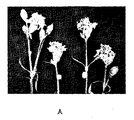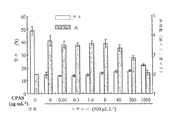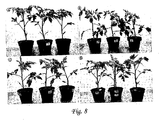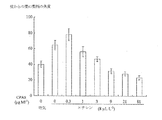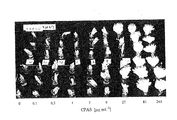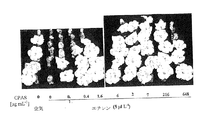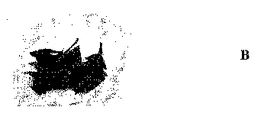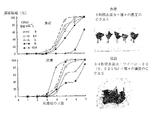JP2010533706A - Compositions and methods for blocking plant ethylene response using 3-cycloprop-I-enyl-propanoate - Google Patents
Compositions and methods for blocking plant ethylene response using 3-cycloprop-I-enyl-propanoate Download PDFInfo
- Publication number
- JP2010533706A JP2010533706A JP2010516652A JP2010516652A JP2010533706A JP 2010533706 A JP2010533706 A JP 2010533706A JP 2010516652 A JP2010516652 A JP 2010516652A JP 2010516652 A JP2010516652 A JP 2010516652A JP 2010533706 A JP2010533706 A JP 2010533706A
- Authority
- JP
- Japan
- Prior art keywords
- cpas
- plant
- ethylene
- fruit
- applying
- Prior art date
- Legal status (The legal status is an assumption and is not a legal conclusion. Google has not performed a legal analysis and makes no representation as to the accuracy of the status listed.)
- Pending
Links
Images
Classifications
-
- A—HUMAN NECESSITIES
- A01—AGRICULTURE; FORESTRY; ANIMAL HUSBANDRY; HUNTING; TRAPPING; FISHING
- A01N—PRESERVATION OF BODIES OF HUMANS OR ANIMALS OR PLANTS OR PARTS THEREOF; BIOCIDES, e.g. AS DISINFECTANTS, AS PESTICIDES OR AS HERBICIDES; PEST REPELLANTS OR ATTRACTANTS; PLANT GROWTH REGULATORS
- A01N3/00—Preservation of plants or parts thereof, e.g. inhibiting evaporation, improvement of the appearance of leaves or protection against physical influences such as UV radiation using chemical compositions; Grafting wax
-
- A—HUMAN NECESSITIES
- A01—AGRICULTURE; FORESTRY; ANIMAL HUSBANDRY; HUNTING; TRAPPING; FISHING
- A01N—PRESERVATION OF BODIES OF HUMANS OR ANIMALS OR PLANTS OR PARTS THEREOF; BIOCIDES, e.g. AS DISINFECTANTS, AS PESTICIDES OR AS HERBICIDES; PEST REPELLANTS OR ATTRACTANTS; PLANT GROWTH REGULATORS
- A01N3/00—Preservation of plants or parts thereof, e.g. inhibiting evaporation, improvement of the appearance of leaves or protection against physical influences such as UV radiation using chemical compositions; Grafting wax
- A01N3/02—Keeping cut flowers fresh chemically
-
- A—HUMAN NECESSITIES
- A01—AGRICULTURE; FORESTRY; ANIMAL HUSBANDRY; HUNTING; TRAPPING; FISHING
- A01N—PRESERVATION OF BODIES OF HUMANS OR ANIMALS OR PLANTS OR PARTS THEREOF; BIOCIDES, e.g. AS DISINFECTANTS, AS PESTICIDES OR AS HERBICIDES; PEST REPELLANTS OR ATTRACTANTS; PLANT GROWTH REGULATORS
- A01N37/00—Biocides, pest repellants or attractants, or plant growth regulators containing organic compounds containing a carbon atom having three bonds to hetero atoms with at the most two bonds to halogen, e.g. carboxylic acids
- A01N37/06—Unsaturated carboxylic acids or thio analogues thereof; Derivatives thereof
-
- A—HUMAN NECESSITIES
- A23—FOODS OR FOODSTUFFS; TREATMENT THEREOF, NOT COVERED BY OTHER CLASSES
- A23B—PRESERVING, e.g. BY CANNING, MEAT, FISH, EGGS, FRUIT, VEGETABLES, EDIBLE SEEDS; CHEMICAL RIPENING OF FRUIT OR VEGETABLES; THE PRESERVED, RIPENED, OR CANNED PRODUCTS
- A23B7/00—Preservation or chemical ripening of fruit or vegetables
- A23B7/14—Preserving or ripening with chemicals not covered by groups A23B7/08 or A23B7/10
- A23B7/153—Preserving or ripening with chemicals not covered by groups A23B7/08 or A23B7/10 in the form of liquids or solids
- A23B7/154—Organic compounds; Microorganisms; Enzymes
Abstract
本発明は、植物の少なくとも一部に、エチレン応答を阻害するのに有効な量の、H1−シクロプロペン−1−プロパン酸塩(CPAS)を適用することを含む、植物のエチレン応答を阻害する方法を開示する。切花に、寿命を延ばすのに有効な量のCPASを適用することを含む、切花の寿命を延ばす方法、及び、(i)4−ブロモ−4−ペンテン酸又はその誘導体を調製する工程と、(ii)1−シクロプロペン−1−プロパン酸を生成する工程と、(iii)この塩を、その水溶性塩、特にナトリウム塩に変換する工程と、を含む、CPASの生成方法を提示する。更に、植物のエチレン応答に対する、水溶性CPAS阻害剤の新規ファミリーを開示する。 The present invention inhibits a plant's ethylene response comprising applying to the at least part of the plant an amount of H1-cyclopropene-1-propanoate (CPAS) effective to inhibit the ethylene response. A method is disclosed. Applying to the cut flowers an amount of CPAS effective to prolong the life, and (i) preparing 4-bromo-4-pentenoic acid or a derivative thereof, and A method for producing CPAS is provided, comprising ii) producing 1-cyclopropene-1-propanoic acid and (iii) converting the salt to its water-soluble salt, in particular the sodium salt. Furthermore, a novel family of water soluble CPAS inhibitors for plant ethylene response is disclosed.
Description
本発明は、一般に、植物及び植物器官又は組織のエチレン応答を遮断する水溶性組成物並びに方法、具体的には、3−シクロプロピル−1−エニル−プロパン酸ナトリウム(又は他の正に帯電した対イオン)塩(CPAS)を植物に適用することにより、植物における種々のエチレンに制御された、生長、再生及び生殖過程を阻害する方法に関する。 The present invention generally relates to water-soluble compositions and methods that block the ethylene response of plants and plant organs or tissues, specifically sodium 3-cyclopropyl-1-enyl-propanoate (or other positively charged) It relates to a method of inhibiting the growth, regeneration and reproductive processes controlled by various ethylene in plants by applying a counter-ion) salt (CPAS) to the plant.
エチレンは、多数の発生過程、具体的には果実の成熟、器官脱離(落果及び落葉)及び老化に関与する天然の植物成長調節因子である。エチレンの有害作用は、農業生産高に被害を与える。 Ethylene is a natural plant growth regulator that is involved in many developmental processes, specifically fruit ripening, organ detachment (fruits and leaves) and senescence. The harmful effects of ethylene can damage agricultural production.
エチレン作用の拮抗剤は、農業利用に非常に有益であると考えられる、なぜなら、内因性及び外因性エチレンの双方から組織を保護するためである。エチレン拮抗剤(EA)は、その受容体部位を遮断することにより、分子レベルでエチレンの作用を阻害する。したがって、EAを適用することにより、作物の収穫期を延長する、果実、ハーブ及び葉菜の貯蔵性及び保存寿命を延ばす、並びに切花の花持ちを延長することを可能にできる。一部のEAの使用は特許により保護されている:ホスホン酸誘導体(米国特許第3879188号)、チオ硫酸銀(米国特許第5510315号)、有機ハロゲン化合物(米国特許第5679617号)、2,5−ノルボルナジエン(米国特許第5834403号)、1−メチルシクロプロペン(1-methylecyclopropene)(米国特許第619350号、同第6365549号)。 Antagonists of ethylene action are believed to be very beneficial for agricultural use because they protect tissues from both endogenous and exogenous ethylene. Ethylene antagonists (EA) inhibit the action of ethylene at the molecular level by blocking its receptor site. Therefore, by applying EA, it is possible to extend the harvest time of crops, extend the shelf life and shelf life of fruits, herbs and leafy vegetables, and extend the longevity of cut flowers. The use of some EAs is protected by patents: phosphonic acid derivatives (US Pat. No. 3,879,188), silver thiosulfate (US Pat. No. 5,510,315), organohalogen compounds (US Pat. No. 5,679,617), 2,5 -Norbornadiene (US Pat. No. 5,834,403), 1-methylecyclopropene (US Pat. Nos. 6,193,350 and 6,365,549).
エチレン応答を遮断する方法の進歩にもかかわらず、安全かつ便利な水溶性遮断剤に対する要求が依然として存在している。 Despite advances in methods for blocking ethylene response, there is still a need for safe and convenient water-soluble blocking agents.
現在利用可能な最も有望なエチレン拮抗剤である、1−メチルシクロプロペン(1−MCP)の使用は、主にそれが水に対して不溶性であるために制限されており、それ故密封した容器内でのみ揮発性形で使用されている。切花への浸漬負荷(dip loading)又は野外における噴霧による適用に使用することはできない。更に、エチレン拮抗剤の選択肢が増えることは、種々の期間エチレン受容体を遮断する阻害剤に対する強い要望を満たすために、商業的に望ましい。17種のエチレン作用のシクロプロペン推定阻害剤が合成され、エチレン拮抗剤としての効力についてスクリーニングされた。新規水かつ安定なシクロプロペン誘導体(CPAS)を更に合成するために、少なくとも12日間バナナの皮の催色を遅延させる、及び少なくとも5日間「ハス(Hass)」アボカド果実の色変化を遅延させる、少なくとも14日間カーネーション及びペチュニアの切花の花持ちを延ばす、並びに少なくとも7日間柑橘類の葉外植片の器官脱離を遅延させる等、農作物におけるエチレン誘導性の有害応答の有効な阻害剤であることが見出されている、最も有望なものを選択した。 The use of 1-methylcyclopropene (1-MCP), the most promising ethylene antagonist currently available, has been limited primarily because it is insoluble in water and is therefore a sealed container Used only in volatile form. It cannot be used for dip loading on cut flowers or field spray application. Furthermore, an increased choice of ethylene antagonists is commercially desirable in order to meet the strong demand for inhibitors that block ethylene receptors for various periods of time. 17 putative cyclopropene inhibitors of ethylene action were synthesized and screened for efficacy as ethylene antagonists. To further synthesize a new water and stable cyclopropene derivative (CPAS), delay the coloration of the banana peel for at least 12 days, and delay the color change of the “Hass” avocado fruit for at least 5 days, It has been found to be an effective inhibitor of ethylene-induced adverse responses in crops, such as extending carnations and petunia cut flowers for at least 14 days, and delaying organ withdrawal of citrus leaf explants for at least 7 days You have chosen the most promising one.
以後、植物のエチレン応答を阻害する方法を本明細書に開示する。本明細書によると、このような方法の1つは、植物に、エチレン応答を阻害するのに有効な量の、更に詳細に記載するCPASを適用することを含む。 Hereinafter, methods for inhibiting plant ethylene responses are disclosed herein. According to the present specification, one such method involves applying to a plant an amount of CPAS described in more detail effective to inhibit the ethylene response.
本発明の別の態様は、植物に、エチレン受容体を遮断するのに有効な量のCPASを適用することにより、植物のエチレン受容体を遮断する方法である。 Another aspect of the invention is a method of blocking a plant ethylene receptor by applying to the plant an amount of CPAS effective to block the ethylene receptor.
本発明の別の態様は、上記定義の方法により、植物のエチレン受容体を遮断する方法であって、前記方法は、表面活性CPAS含有水溶液が得られるように、有効な量のCPASを界面活性剤と混合する工程を更に含む。 Another aspect of the present invention is a method for blocking plant ethylene receptors according to the method defined above, wherein said method comprises applying an effective amount of CPAS to obtain a surface active CPAS-containing aqueous solution. The method further includes mixing with the agent.
また、植物に、器官脱離を阻害するのに有効な量のCPASを適用することを含む、植物の器官脱離を阻害する方法を開示する。 Also disclosed is a method of inhibiting plant organ detachment comprising applying to the plant an amount of CPAS effective to inhibit organ detachment.
また、切花に、寿命を延ばすのに有効な量のCPASを適用することを含む、切花の寿命を延ばす方法を開示する。 Also disclosed is a method for extending the life of a cut flower comprising applying to the cut flower an amount of CPAS effective to extend the life.
また、収穫した果実に、阻害に有効な量のCPASを適用することを含む、収穫した果実の成熟を阻害する方法を開示する。また、収穫した野菜に、阻害に有効な量のCPASを適用することを含む、収穫した野菜の成熟を阻害する方法を開示する。本明細書に記載する方法は、(i)水溶液若しくはエアゾール、若しくは懸濁液、若しくはエマルションの;(ii)又は植物、切花、摘み取った果実若しくは摘み取った野菜を、CPAS水溶液を含有する雰囲気中に導入することにより;(iii)又は粉末、微粒子、例えばナノ粉末、粒子状物質等のいずれかの、CPASで植物を処理することによる等の、多数の好適な方式で実施してよい。これらの及び他の好適な適用方法を以下に詳細に論じる。 Also disclosed is a method for inhibiting the ripening of harvested fruit comprising applying to the harvested fruit an effective amount of CPAS. Also disclosed is a method for inhibiting maturity of harvested vegetables comprising applying to the harvested vegetables an effective amount of CPAS for inhibition. The method described herein comprises (i) an aqueous solution or aerosol, or suspension or emulsion; (ii) or a plant, cut flower, picked fruit or picked vegetable in an atmosphere containing an aqueous CPAS solution. By introduction; (iii) or any of powders, microparticles such as nanopowder, particulate matter, etc., may be carried out in a number of suitable ways, such as by treating plants with CPAS. These and other suitable application methods are discussed in detail below.
したがって、本発明の目的は、植物の少なくとも一部に、エチレン応答を阻害するのに有効な量の、式(1):
適用工程は、前記化合物を、前記化合物を含む水溶液に接触させることにより実施されると思われる。本発明によるCPASは、リチウム、ナトリウム、カリウム、アンモニウム、カルシウム、マグネシウム等、及び少なくとも1つの硫酸塩若しくはリン酸塩分子を含む正に帯電した対イオン、又はこれらの組み合わせの群から非限定的な方式で選択された塩であり、特にナトリウム塩である。適用工程は、前記植物の少なくとも一部を溶液に浸漬する、溶液を噴霧する、かける又は液滴を放出する、接触させる、及びはけ塗りする、のうち1つ又はそれ以上の手順により実施されると思われる。エチレン応答は、果実の成熟、野菜の成熟、花の老化、器官脱離、収穫した果実、収穫した野菜又はこれらの組み合わせから、非限定的な方式で選択される。 The application step appears to be performed by contacting the compound with an aqueous solution containing the compound. CPAS according to the present invention is non-limiting from the group of lithium, sodium, potassium, ammonium, calcium, magnesium, etc., positively charged counterions comprising at least one sulfate or phosphate molecule, or combinations thereof The salt selected in the manner, in particular the sodium salt. The applying step is performed by one or more procedures of immersing at least a part of the plant in the solution, spraying the solution, applying or discharging droplets, contacting, and brushing. It seems to be that. The ethylene response is selected in a non-limiting manner from fruit ripening, vegetable ripening, flower senescence, organ detachment, harvested fruit, harvested vegetable, or combinations thereof.
本発明の別の目的は、カットフルーツに、寿命を延ばすのに有効な量の、式(1)により定義される化合物を適用することを含む、収穫した果実の寿命を延ばす方法を開示することである。適用工程は、前記植物の少なくとも一部に、溶液を接触させる、浸漬する、噴霧する、かける又は液滴を放出する、はけ塗りする、のうち1つ又はそれ以上の手順により実施されると思われる。エチレン応答は、果実の成熟、野菜の成熟、花の老化、器官脱離、収穫した果実、収穫した野菜又はこれらの組み合わせから、非限定的な方式で選択される。 Another object of the present invention is to disclose a method for extending the life of harvested fruits comprising applying to the cut fruit an amount of a compound defined by formula (1) effective to extend the life. It is. The applying step is performed by one or more procedures of contacting, dipping, spraying, spraying or discharging droplets, brushing, at least a part of the plant. Seem. The ethylene response is selected in a non-limiting manner from fruit ripening, vegetable ripening, flower senescence, organ detachment, harvested fruit, harvested vegetable, or combinations thereof.
本発明の別の目的は、切花に、寿命を延ばすのに有効な量の、式(1)により定義される化合物を適用することを含む、切花の寿命を延ばす方法を開示することである。適用工程は、前記植物の少なくとも一部に、溶液を接触させる、浸漬する、噴霧する、かける又は液滴を放出する、はけ塗りする、のうち1つ又はそれ以上の手順により実施されると思われる。 Another object of the present invention is to disclose a method for extending the lifespan of a cut flower comprising applying to the cut flower an amount of a compound defined by formula (1) effective to extend the lifespan. The applying step is performed by one or more procedures of contacting, dipping, spraying, spraying or discharging droplets, brushing, at least a part of the plant. Seem.
本発明の別の目的は、式(1)により特徴付けられる、植物のエチレン応答のシクロプロピル−1−エニル−プロパン酸ナトリウム塩(CPAS)阻害剤を開示することである。CPAS阻害剤は、浸漬する、はけ塗りする、かける若しくは液滴を放出する、噴霧する又はこれらの任意の組み合わせの群から選択される、市販の手段により植物の少なくとも一部に適用するのに適合した、周囲条件(温度及び圧力)で優位に液体形であると思われる。あるいは又は更に、上記のいずれかで定義したようなCPASを、有効な量まで、水溶液に溶解、分散又は混合する。 Another object of the invention is to disclose a plant ethylene-responsive cyclopropyl-1-enyl-propanoic acid sodium salt (CPAS) inhibitor characterized by the formula (1). The CPAS inhibitor is applied to at least a part of the plant by commercially available means selected from the group of dipping, brushing, applying or releasing droplets, spraying or any combination thereof. Appears to be predominantly liquid in ambient conditions (temperature and pressure). Alternatively or additionally, CPAS as defined above is dissolved, dispersed or mixed in an aqueous solution to an effective amount.
本発明の別の目的は、上記定義のようなCPASを開示することであって、前記CPASは表面活性CPAS含有水溶液が得られるように提供される。 Another object of the present invention is to disclose a CPAS as defined above, said CPAS being provided so as to obtain a surface active CPAS-containing aqueous solution.
本発明は、添付図面を参照して、実施例を用いて、より詳細に記載される。 The invention will now be described in more detail by way of example with reference to the accompanying drawings.
本発明を実施するために用いてよいCPASは、式I:
用語「植物」は、本明細書では一般的な意味で用いられ、草本性、並びに、木及び低木のような木質茎植物を含む。本明細書に記載の方法により処理される植物としては、植物全体、並びに、農作物、鉢植え植物、切花(茎及び花)及び収穫した果実及び野菜のようなその任意の一部が挙げられる。前記化合物で及び本発明の方法により処理された植物は、好ましくは、非植物毒性量のCPASで処理される。 The term “plant” is used herein in a general sense and includes herbaceous and woody stem plants such as trees and shrubs. Plants to be treated by the methods described herein include whole plants and any part thereof such as crops, potted plants, cut flowers (stems and flowers) and harvested fruits and vegetables. Plants treated with the compounds and by the methods of the present invention are preferably treated with a non-phytotoxic amount of CPAS.
用語「水溶液」は、以後、少なくとも部分的に水に混和性である溶液を指す。上記にかかわらず、CPASは粉末形、錠剤、エアゾール、エマルション、懸濁液、水混和性若しくは水不混和性溶液、又は任意の他の農業的方式で提供されると思われる。 The term “aqueous solution” hereinafter refers to a solution that is at least partially miscible in water. Regardless of the above, CPAS may be provided in powder form, tablets, aerosols, emulsions, suspensions, water-miscible or water-immiscible solutions, or any other agricultural manner.
本発明を使用して、様々な異なるエチレン応答を調整することができる。エチレン応答は、内因性及び外因性源のエチレンのいずれによっても開始され得る。エチレン応答としては、例えば、花、果実及び野菜の成熟及び/又は老化、葉、花及び果実の器官脱離、鉢植え植物、切花、植え込み、種子及び休眠中の苗のような観賞植物の寿命を縮める、一部の植物(例えばエンドウマメ)で生長を阻害する、並びに他の植物(例えば、イネ)で生長を刺激することが挙げられる。 The present invention can be used to adjust a variety of different ethylene responses. The ethylene response can be initiated by both endogenous and exogenous sources of ethylene. Ethylene responses include, for example, the life of ornamental plants such as flower, fruit and vegetable ripening and / or senescence, leaf, flower and fruit organ detachment, potted plants, cut flowers, planting, seeds and dormant seedlings. Shrinking, inhibiting growth in some plants (eg, peas), and stimulating growth in other plants (eg, rice).
本発明のCPASにより阻害できる更なるエチレン応答又はエチレン型応答としては、直接又は間接的オーキシン活性、頂端生長の阻害、頂芽優勢の制御、分枝の増加、代謝産物及び副生成物の代謝及び濃度の増加又は減少、植物の生化学組成の変化(茎面積に対する葉面積の増加等)、開花及び種子の発生の失敗又は阻害、倒伏作用、種子の発芽の刺激及び休眠の中断、並びにホルモン又は上偏生長作用が挙げられるが、これらに限定されない。 Additional ethylene or ethylene-type responses that can be inhibited by the CPAS of the present invention include direct or indirect auxin activity, inhibition of apical growth, control of apical dominance, increased branching, metabolite and byproduct metabolism and Increase or decrease in concentration, change in biochemical composition of plants (increased leaf area relative to stem area, etc.), failure or inhibition of flowering and seed development, lodging action, stimulation of seed germination and interruption of dormancy, and hormone or Examples include, but are not limited to, an uplifting action.
本発明の実施形態による方法は、野菜の成熟及び/又は老化を阻害する。本明細書で使用するとき、「野菜の成熟」とは、まだ植物に実っている状態の野菜の成熟及び野菜が実っている植物から収穫された後の野菜の成熟を含む。成熟及び/又は老化を阻害するために、本発明の方法により処理できる野菜としては、レタス(例えば、Lactuea sativa)、ホウレンソウ(Spinaca oleracea)、及びキャベツ(Brassica oleracea)のような葉物野菜、ジャガイモ(Solanum tuberosum)及びニンジン(Daucus)のような種々の根菜、タマネギ(Allium sp.)のような鱗茎、バジル(Ocimum basilicum)、オレガノ(Origanum vulgare)、ディル(Anethum graveolens)のようなハーブ、並びにダイズ(Glycine max)、ライマメ(Phaseolus limensis)、エンドウマメ(Lathyrus spp.)、トウモロコシ(Zea mays)、ブロッコリー(Brassica oleracea
italica)、カリフラワー(Brassica oleracea
botrytis)及びアスパラガス(Asparagus officinalis)が挙げられる。
The method according to embodiments of the present invention inhibits vegetable ripening and / or aging. As used herein, “vegetable maturity” includes maturation of a vegetable that is still growing on the plant and maturation of the vegetable after it has been harvested from the plant on which the vegetable is growing. Vegetables that can be treated by the method of the invention to inhibit maturation and / or senescence include leafy vegetables such as lettuce (eg Lactuea sativa), spinach (Spinaca oleracea), and cabbage (Brassica oleracea), potatoes (Solanum tuberosum) and various root vegetables such as carrots (Daucus), bulbs such as onions (Allium sp.), Basil (Ocimum basilicum), oregano (Origanum vulgare), herbs such as dill (Anethum graveolens), and Soybean (Glycine max), Lima bean (Phaseolus limensis), Pea (Lathyrus spp.), Corn (Zea mays), Broccoli (Brassica oleracea)
italica), cauliflower (Brassica oleracea)
botrytis) and asparagus (Asparagus officinalis).
本発明の実施形態による方法は果実の成熟を阻害する。本明細書で使用するとき、「果実の成熟」とは、まだ植物に実っている状態の果実の成熟に加えて、果実が実っている植物から収穫された後の果実の成熟を含む。成熟を阻害するために本発明の方法により処理できる果実としては、トマト(Lycopersicon esculentum)、リンゴ(Malus domestica)、バナナ(Musa sapientum)、セイヨウナシ(Pyrus communis)、パパイヤ(Carica papaya)、マンゴー(Mangifera indica)、モモ(Prunus persica)、アプリコット(Prunus armeniaca)、ネクタリン(Prunus persica nectarina)、オレンジ(Citrus sp.)、レモン(Citrus limonia)、ライム(Citrus aurantifolia)、グレープフルーツ(Citrus paradisi)、タンジェリン(Citrus
nobilis deliciosa)並びに他の市販品種、雑種、及び新たに開発された品種、キウィ(Actinidia chinenus)、パイナップル(Aranas comosus)、カキ(Diospyros sp.)、アボカド(Persea americana)並びに他の市販品種、雑種及び新たに開発された品種が挙げられる。
The method according to embodiments of the present invention inhibits fruit ripening. As used herein, “fruit ripening” includes fruit ripening after the fruit is harvested from the fruit-bearing plant, in addition to fruit ripening that is still fruiting in the plant. Fruits that can be treated by the method of the invention to inhibit maturation include tomato (Lycopersicon esculentum), apple (Malus domestica), banana (Musa sapientum), pear (Pyrus communis), papaya (Carica papaya), mango ( Mangifera indica), peach (Prunus persica), apricot (Prunus armeniaca), nectarine (Prunus persica nectarina), orange (Citrus sp.), Lemon (Citrus limonia), lime (Citrus aurantifolia), grapefruit (Citrus paradisi), tangerine ( Citrus
nobilis deliciosa) and other commercial varieties, hybrids and newly developed varieties, Kiwi (Actinidia chinenus), pineapple (Aranas comosus), oyster (Diospyros sp.), avocado (Persea americana) and other commercial varieties, hybrids And newly developed varieties.
老化を阻害する並びに/又は花の寿命及び外観を長持ちさせる(黄変及び器官脱離を遅延させる)ために本発明の方法により処理できる観賞植物としては、鉢植え観賞植物及び切花が挙げられる。本発明で処理できる鉢植え観賞植物及び切花としては、ツツジ(Rhododendron spp.)、アジサイ(Mαcrophyllα hydrangea)、ハイビスカス(Hibiscus rosasanensis)、スナップドラゴン(Antirrhinum sp.)、ポインセチア(Euphorbia pulcherima)、サボテン(例えば、Cactaceae schlumbergera
truncata)、ベゴニア(Begonia sp.)、バラ(Rosa spp.)、チューリップ(Tulipa sp.)、スイセン(Narcissus spp.)、ペチュニア(Petunia hybrida)、カーネーション(Dianthus caryophyllus)、ユリ(例えば、Lilium sp.)、グラジオラス(Gladiolus sp.)、アルストロメリア(Alstoemeria brasiliensis)、アネモネ(例えば、Anemone
blanda)、オダマキ(Aquilegia sp.)、アラリア(例えば、Aralia chinensis)、シオン(例えば、Aster carolinianus)、ブーゲンビリア(Bougainvillea
sp.)、ツバキ(Camellia sp.)、ホタルブクロ(Campanula
sp.)、ケイトウ(celosia sp.)、フォールスサイプレス(Chamaecyparis sp.)、キク(Chrysanthemum sp.)、クレマチス(Clematis sp.)、シクラメン(Cyclamen sp.)、フリージア(例えば、Freesia refracta)、及びラン科のラン、並びに他の市販品種、雑種及び新たに開発された品種が挙げられる。
Ornamental plants that can be treated by the method of the present invention to inhibit senescence and / or prolong the life and appearance of flowers (delay yellowing and organ detachment) include potted ornamental plants and cut flowers. Potted ornamental plants and cut flowers that can be treated in the present invention include azaleas (Rhododendron spp.), Hydrangea (Mαcrophyllα hydrangea), hibiscus (Hibiscus rosasanensis), snap dragon (Antirrhinum sp.), Poinsettia (Euphorbia pulcherima), cacti (for example, Cactaceae schlumbergera
truncata, Begonia sp., Rose (Rosa spp.), Tulip (Tulipa sp.), Narcissus (Narcissus spp.), Petunia hybrida, Carnation (Dianthus caryophyllus), Lily (eg Lilium sp.) ), Gladiolus sp., Alstoemeria brasiliensis, Anemone (eg Anemone)
blanda), Aquilegia sp., Aralia (eg, Aralia chinensis), Zion (eg, Aster carolinianus), Bougainvillea (Bougainvillea)
sp.), camellia (Camellia sp.), firefly (Campanula)
sp.), celosia sp., false cypress (Chamaecyparis sp.), chrysanthemum sp., clematis sp., cyclamen sp., freesia (eg, Freesia refracta), and orchid Family orchids, as well as other commercial varieties, hybrids and newly developed varieties.
葉、花及び果実の器官脱離を阻害するために本発明の方法により処理できる植物としては、リンゴ、セイヨウナシ、サクランボ(Prunus avium)、ペカン(Carva illinoensis)、ブドウ(Vitis vinifera)、オリーブ(例えば、Vitis vinifera及びOlea europaea)、コーヒー(Coffea arabica)、インゲンマメ(Phaseolus vulgaris)、オレンジ(Citrus sp.)、レモン(Citrus limonia)、ライム(Citrus
aurantifolia)、グレープフルーツ(Citrus paradisi)、タンジェリン(Citrus nobilis deliciosa)及び他の市販品種、雑種及び新たに開発された品種、並びにシダレガジュマル(Ficus benjamina)に加えて、リンゴ、観賞植物、低木及び苗木を含む種々の果樹のような休眠苗が挙げられる。更に、葉の器官脱離を阻害するために本発明により処理できる低木としては、イボタ(Ligustrum sp.)、カナメモチ(Photinia sp.)、モチノキ(Ilex sp.)、ウラボシ科のシダ、フカノキ(Schefflera sp.)、アグラオネマ(Aglaonema sp.)、コトネアスター(Cotoneaster sp.)、メギ(Berberis sp.)、ヤマモモ(Myrica sp.)、アベリア(Abelia sp.)、アカシア(Acacia sp.)及びパイナップル科のブロミリアド、並びに他の市販品種、雑種及び新たに開発された品種が挙げられる。
Plants that can be treated by the method of the present invention to inhibit organ detachment of leaves, flowers and fruits include apples, pears, cherries (Prunus avium), pecans (Carva illinoensis), grapes (Vitis vinifera), olives ( For example, Vitis vinifera and Olea europaea), coffee (Coffea arabica), common bean (Phaseolus vulgaris), orange (Citrus sp.), Lemon (Citrus limonia), lime (Citrus)
In addition to aurantifolia), grapefruit (Citrus paradisi), tangerine (Citrus nobilis deliciosa) and other commercial varieties, hybrids and newly developed varieties, and weeping regex (Ficus benjamina), apples, ornamental plants, shrubs and seedlings Examples include dormant seedlings such as various fruit trees. In addition, shrubs that can be treated according to the present invention to inhibit leaf organ detachment include ibota (Ligustrum sp.), Kanamachichi (Photinia sp.), Ilex sp., Fern of the family Labrichidae, Schefflera sp.), Aglaonema sp., Cotoneaster sp., Berberis sp., Bayberry (Myrica sp.), Abelia sp., Acacia sp. and the pineapple family Bromyriad, as well as other commercial varieties, hybrids and newly developed varieties.
CPASは、低濃度で適用されたときでさえ、植物、果実及び野菜に対するエチレン作用の予想以上に強力な阻害剤であることが証明されている。とりわけ、この化合物は、水に可溶性かつ安定性であり、そのため植物、カットフルーツ及びカット野菜、切花に活性物質を送達するための種々の方法の使用が可能になる。全ての対象に、CPAS水溶液をはけ塗り又は浸漬することができ、又はその溶液を噴霧することができ、界面活性剤の負荷は阻害剤の浸透を向上させることができる。更に、果実、野菜及び花の切断面を、一定の時間CPAS溶液に浸漬することができる。 CPAS has proven to be a more potent inhibitor of ethylene action on plants, fruits and vegetables even when applied at low concentrations. In particular, this compound is soluble and stable in water, thus allowing the use of various methods for delivering active substances to plants, cut fruits and vegetables, cut flowers. All objects can be brushed or dipped with an aqueous CPAS solution, or the solution can be sprayed, and surfactant loading can improve the penetration of the inhibitor. Furthermore, the cut surfaces of fruits, vegetables and flowers can be immersed in the CPAS solution for a certain time.
水溶性3−(1−シクロプロペニル)プロパン酸及びそのナトリウム又は他の正に帯電した(1価又は2価)対イオン塩の合成を以下に記載する。 The synthesis of water-soluble 3- (1-cyclopropenyl) propanoic acid and its sodium or other positively charged (monovalent or divalent) counterion salts is described below.
シクロプロペン化合物の最も簡単かつ最も信頼できる方法を示した参考文献の分析は、リチウム有機化合物の作用により、1,2,2−シクロプロパン又はその誘導体から3つの臭素原子を脱離させることである。1,2,2−トリブロモシクロプロパン化合物は、ジブロモカルベンと2−ブロモ−1−アルケン又はその誘導体との反応により調整される。それ故、市販の試薬から、規則化合物を生成する手順は、3つの主な合成工程から成る:第1は、4−ブロモ−4−ペンテン酸又はその誘導体の調製であり;第2工程は、3−(1−シクロプロペニル)プロパン酸の生成であり;第3工程は、この酸のナトリウム塩への変換である。リチウム、ナトリウム、カリウム、アンモニウム、カルシウム、マグネシウム及び、例えば少なくとも1つの硫酸塩又はリン酸塩分子を含む正に帯電した対イオン塩のような他の塩も可能である。とりわけ正に帯電したアルキル含有化合物を含む有機塩もまた可能である。 An analysis of the reference that showed the simplest and most reliable method of cyclopropene compounds is to desorb three bromine atoms from 1,2,2-cyclopropane or its derivatives by the action of lithium organic compounds. . The 1,2,2-tribromocyclopropane compound is prepared by reacting dibromocarbene with 2-bromo-1-alkene or a derivative thereof. Therefore, the procedure for generating ordered compounds from commercially available reagents consists of three main synthetic steps: the first is the preparation of 4-bromo-4-pentenoic acid or a derivative thereof; the second step is The formation of 3- (1-cyclopropenyl) propanoic acid; the third step is the conversion of this acid to the sodium salt. Other salts are possible, such as lithium, sodium, potassium, ammonium, calcium, magnesium and, for example, positively charged counterion salts containing at least one sulfate or phosphate molecule. Organic salts containing in particular positively charged alkyl-containing compounds are also possible.
本発明の1つの実施形態による合成の全スキームは、以下の6つの段階を含み、ここでは、例として、非限定的な方式で、水溶性ナトリウムCPASの合成を提供する:
1. BrCH2CH2OH
+ CH2=CH-OC2H5 → BrCH2CH2OCH(CH3)OC2H5.
2a.
Mg + BrCH2CH2OR → BrMgCH2CH2OR
(式中、RはCH(CH3)OC2H5である)
2b.
BrMgCH2CH2OR + CH2=CBr-CH2Br → CH2=CBr-CH2CH2CH2OR
3a.
CHBr3 + NaOH → CBr2 + NaBr +H2O
3b.
1. BrCH 2 CH 2 OH
+ CH 2 = CH-OC 2 H 5 → BrCH 2 CH 2 OCH (CH 3 ) OC 2 H 5 .
2a.
Mg + BrCH 2 CH 2 OR → BrMgCH 2 CH 2 OR
(Wherein, R CH (CH 3) is OC 2 H 5)
2b.
BrMgCH 2 CH 2 OR + CH 2 = CBr-CH 2 Br → CH 2 = CBr-CH 2 CH 2 CH 2 OR
3a.
CHBr 3 + NaOH → CBr 2 + NaBr + H 2 O
3b.
得られる最終生成物の構造は、いくつかのスペクトル法:1H、13C、23Na NMR、MS、赤外分光法により明らかになる。純度は、HPLC及びHPTLC方法により定められる。約0.2gの3−(1−シクロプロペニル)プロパン酸が得られ、その精製方法が開発されている。 The structure of the final product obtained is revealed by several spectral methods: 1 H, 13 C, 23 Na NMR, MS, infrared spectroscopy. Purity is determined by HPLC and HPTLC methods. About 0.2 g of 3- (1-cyclopropenyl) propanoic acid is obtained, and a purification method has been developed.
本発明は、以下の非限定的な実施例でより詳細に説明される。 The invention is explained in more detail in the following non-limiting examples.
エチレン作用の拮抗における水溶性CPASの最低有効濃度を決定するために、熟しているが成熟していない果実:緑のバナナ果実;緑のアボカド「ハス」果実;及び熟しているが成熟していないモモ果実、切花:カーネーション;カーネーションの花弁;及びペチュニアの花、トマト苗;及び柑橘類の葉外植片を用いて、試験を実施した。上記に列挙した植物材料をCPAS溶液±エチレン曝露で処理した。CPAS(μg/mL)の最低の見かけ上の濃度及びそれらの植物材料が保護された時間(日)を表1に示す。
各種類のモデル植物を、前処理として6〜18時間、様々な濃度の水溶液中のCPASに曝露し、続いて24時間様々な濃度のエチレンに曝露した。バナナ及びアボカド果実の場合、エチレン前処理として市販のツイーン−20界面活性剤(0.025%)の存在下で、様々な濃度のCPAS水溶液を皮にはけ塗りし、空気対照に対する、色が分解するまで(バナナでは緑から黄色に(表1、図4)、アボカドでは緑から黒に(表1、図6))に経過した遅延日数を、エチレン拮抗剤の効率の基準として記録した。モモ果実の場合は、界面活性剤BAS70(ドイツのBASFにより大量に供給されている)を用いた。制御条件下で2〜4日間インキュベートした後、結果を記録した(表1、図11)。切花モデルを用いたときは(図1〜3)、CPAS水溶液±界面活性剤を、エチレン処理前にCPAS水溶液中で18時間、切花又は分離した花弁のいずれかに負荷することにより適用した。花の視覚的しおれに従って、水対照に対する、試験した植物材料の老化の遅延日数を記録した。葉の葉柄のエチレン誘導性上偏生長を拮抗するために(表1、図8〜9)、CPAS溶液を噴霧する前又は下方茎切断面を介して切り取った苗によりCPAS負荷する前(表1、図10)、8〜10時間生育箱内で検定のために維持された、市販の「キネティック」オルガノシリコーン界面活性剤ブレンドの存在下で、CPAS水溶液をトマト苗に噴霧した。柑橘類の葉外植片の場合では、薄層器官脱離領域で、器官脱離を試験した。水溶液中のCPASは、17時間外植片の近位側に処理溶液を直接負荷することにより、又は市販のツイーン−20(登録商標)界面活性剤(0.025%)の存在下で30〜60秒間試験した溶液中に外植片全体を浸漬することにより、前処理した。全ての場合、検査した全ての植物系で、エチレンに誘導される応答の作用の著しい遅延が記録された(表1、図7)。更なる実施例では、CPAS水溶液濃度を、上記実験で得られた結果の範囲で用いた。 Each type of model plant was exposed to CPAS in various concentrations of aqueous solution for 6-18 hours as a pre-treatment, followed by exposure to various concentrations of ethylene for 24 hours. In the case of banana and avocado fruits, various concentrations of CPAS aqueous solution are brushed onto the skin in the presence of a commercially available Tween-20 surfactant (0.025%) as an ethylene pretreatment, and the color relative to the air control is The number of days delayed until degradation (from green to yellow for banana (Table 1, FIG. 4) and from green to black for Avocado (Table 1, FIG. 6)) was recorded as a measure of ethylene antagonist efficiency. In the case of peach fruit, the surfactant BAS70 (supplied in large quantities by BASF in Germany) was used. After incubation for 2-4 days under controlled conditions, the results were recorded (Table 1, FIG. 11). When the cut flower model was used (FIGS. 1-3), the CPAS aqueous solution ± surfactant was applied by loading either cut flowers or separated petals in CPAS aqueous solution for 18 hours prior to ethylene treatment. According to the visual wilting of the flowers, the days of aging of the plant material tested were recorded relative to the water control. In order to antagonize the ethylene-induced upregulation of leaf petioles (Table 1, FIGS. 8-9), before spraying with CPAS solution or before CPAS loading with seedlings cut through the lower stem cut surface (Table 1) , FIG. 10), CPAS aqueous solution was sprayed onto tomato seedlings in the presence of a commercial “kinetic” organosilicone surfactant blend maintained for assay in a growth box for 8-10 hours. In the case of citrus leaf explants, organ detachment was tested in the lamellar organ detachment region. CPAS in aqueous solution is 30-30 in the presence of a commercial Tween-20® surfactant (0.025%) by loading the treatment solution directly on the proximal side of the explant for 17 hours. It was pretreated by immersing the entire explant in the solution tested for 60 seconds. In all cases, significant delays in the effects of the response induced by ethylene were recorded in all plant systems examined (Table 1, FIG. 7). In further examples, CPAS aqueous solution concentrations were used within the range of results obtained in the above experiments.
以下の試験は、水溶液中の水溶性CPASの、分離したカーネーションの花弁のエチレンに誘導される老化を遅延させる能力を更に定めるために設計した。実験は、最適な環境条件(光、温度及び相対湿度)を保証するために生育箱内で実施した。カーネーションの花弁は、その切断面を18時間、81μg/mLのCPASを含有する水溶液中に浸漬することにより、CPAS負荷した。未処理の花弁は水中に保持された。18時間後、処理した花弁を水に移した。その後、全ての花弁を24時間エチレン(5μl/L)に曝露した。処理の終わりに、その老化値を評価するために、水中に浸漬された切断面を有する花弁を、連続蛍光灯下で22℃及びRH80%に維持した。6日目に写真を撮影した(未処理−図1A、処理−図1B)。 The following tests were designed to further define the ability of water soluble CPAS in aqueous solution to retard ethylene-induced aging of isolated carnation petals. Experiments were performed in a growth box to ensure optimal environmental conditions (light, temperature and relative humidity). The carnation petals were CPAS loaded by immersing their cut surfaces in an aqueous solution containing 81 μg / mL CPAS for 18 hours. Untreated petals were kept in water. After 18 hours, the treated petals were transferred to water. All petals were then exposed to ethylene (5 μl / L) for 24 hours. At the end of the treatment, the petals with cut surfaces immersed in water were maintained at 22 ° C. and 80% RH under continuous fluorescent light in order to assess their aging value. A photograph was taken on day 6 (untreated—FIG. 1A, treated—FIG. 1B).
6日後に測定された水溶液中のCPASのエチレン拮抗効果は、非常に著しかった。実験の過程で、毒性症状は観察されなかった。 The ethylene antagonistic effect of CPAS in aqueous solution measured after 6 days was very significant. No toxic symptoms were observed during the course of the experiment.
カーネーションの切花を、8μg/mLのCPASを含有する水溶液中に18時間切断面を浸漬することにより処理した。未処理の花は、水中に保持した。処理後、花持ちを評価するために、全ての花を、連続蛍光灯下にて、22℃及びRH80%で水中に維持した。14日目に写真を撮影した。得られた結果は、未処理の花に比べて(図2A)、水溶液中にCPASが存在する場合は(図2B)花持ちに関してカーネーションの切花の寿命増加を示す。 Carnation cut flowers were treated by immersing the cut surface in an aqueous solution containing 8 μg / mL CPAS for 18 hours. Untreated flowers were kept in water. After treatment, all flowers were kept in water at 22 ° C. and 80% RH under continuous fluorescent light to assess flower retention. A photo was taken on the 14th day. The results obtained show an increase in the lifetime of carnation cut flowers with respect to flower retention when CPAS is present in the aqueous solution (FIG. 2B) compared to untreated flowers (FIG. 2A).
短茎ペチュニア切花を、98μg/mLのCPASを含有する水溶液中に18時間切断面を浸漬することにより、水溶性CPASを負荷した。未処理の花は水中に保持した。負荷の18時間後、処理した花を水に移動させた。次いで、花を24時間エチレン(5μl/L)に曝露して、花の老化を加速させた。処理の終わりに、切断面を水に浸漬した花を、花持ちを評価するために、連続蛍光灯下にて、22℃及びRH80%でインキュベートした。14日目に写真を撮影した(未処理−図3A、処理−図3B)。 A short petunia cut flower was loaded with water-soluble CPAS by immersing the cut surface in an aqueous solution containing 98 μg / mL CPAS for 18 hours. Untreated flowers were kept in water. After 18 hours of loading, the treated flowers were moved to water. The flowers were then exposed to ethylene (5 μl / L) for 24 hours to accelerate flower senescence. At the end of the treatment, the flowers whose cut surfaces were immersed in water were incubated at 22 ° C. and 80% RH under continuous fluorescent light in order to assess their longevity. Photographs were taken on day 14 (untreated—FIG. 3A, treated—FIG. 3B).
ペチュニアは、エチレンに感受性であることが既知であり、したがって、エチレン応答を研究するためのモデル系として用いられることが多い。この実験の結果は、前の実験に完全に一致し、水中に可溶性形で適用されるときの、エチレン拮抗剤としてのCPASの有効性を更に支持する。 Petunia is known to be sensitive to ethylene and is therefore often used as a model system to study ethylene response. The results of this experiment are in complete agreement with previous experiments and further support the effectiveness of CPAS as an ethylene antagonist when applied in soluble form in water.
バナナの果実を、水溶性CPASの水溶液(200μg/mL)ではけ塗りすることにより処理した。18時間後、全ての処理した及び未処理の果実を、エチレン(300μl/L)に曝露し、成熟を加速させた。全ての果実に酸素を供給し、成熟値を評価するために、22℃及びRH92%で空気中に保持した。12日目に写真を撮影した(未処理−図4A、処理−図4B)。 Banana fruits were treated by brushing with an aqueous solution of water-soluble CPAS (200 μg / mL). After 18 hours, all treated and untreated fruits were exposed to ethylene (300 μl / L) to accelerate ripening. All fruits were oxygenated and kept in air at 22 ° C. and RH 92% to assess maturity values. Photographs were taken on day 12 (untreated—FIG. 4A, treated—FIG. 4B).
更に、バナナ果実を、CPASの水溶液(0.6〜1000μg/μL、及び市販の界面活性剤ツイーン−20(0.025%))をはけ塗りすることにより処理し、18時間後エチレン(300μl/L)に24時間曝露して、成熟を加速させた。果実を24℃及びRH92%で保持した。果実を空気中に保持し、CPASのみで処理し、これを比較例とする。結果を7日目に収集した(図5A)。 Further, the banana fruit was treated by brushing with an aqueous solution of CPAS (0.6-1000 μg / μL, and commercially available surfactant Tween-20 (0.025%)), and after 18 hours ethylene (300 μl / L) for 24 hours to accelerate maturation. The fruit was kept at 24 ° C. and RH 92%. The fruit is held in the air and treated with CPAS alone, which is used as a comparative example. Results were collected on day 7 (FIG. 5A).
CPASの水溶液(1000μg/mL)は、果実の堅さの減少の遅延に関して効果がなく、これは果実の貯蔵寿命を延長しないことを意味する。それにもかかわらず、果実の色分解を著しく遅延させることは見出されていた(図4)。図5Aは、CPAS及びエチレン曝露に関して、バナナ果実の堅さ及び色の依存性を示す図を表す。ここに見られるように、それぞれ堅さ及び色に対して、水溶液中のCPASの二重の負及び正の効果が存在する。堅さは25Nを著しく下回るまで低下し、果実は、18時間の空気による前処理と、それに続く24時間のエチレンへの曝露後、十分食用に適していた。色分解のパターンはまさに逆であり、その時点でほぼ完了していた。CPASの負荷は、全ての濃度において、果実の堅さの低下をほとんど防がなかったが、一方色分解の防止については、高濃度で有効であった。 An aqueous solution of CPAS (1000 μg / mL) has no effect on the delay in reducing fruit firmness, meaning that it does not extend the shelf life of the fruit. Nevertheless, it has been found to significantly delay fruit color separation (FIG. 4). FIG. 5A represents a diagram showing the dependence of banana fruit firmness and color on CPAS and ethylene exposure. As can be seen here, there are double negative and positive effects of CPAS in aqueous solution on stiffness and color, respectively. The firmness dropped to well below 25 N and the fruit was well edible after 18 hours of air pretreatment followed by 24 hours of ethylene exposure. The pattern of color separation was exactly the reverse and was almost complete at that time. CPAS loading hardly prevented the reduction of fruit firmness at all concentrations, while it was effective at higher concentrations for preventing color separation.
長い花柄を有する「ハス」アボカド果実を、100μg/mLのCPASを含有する水溶液中に30時間、花柄切断面を浸漬することにより、水溶性CPASを負荷した。未処理の花柄を有する果実は水に浸漬した。CPAS処理後、全ての果実を24時間エチレン(250μl/L)に曝露した。その後、果実を、成熟パラメータ(皮の色変化及び果肉の堅さ)及び花柄の器官脱離を評価するために、24℃及びRH92%で保持した。処理の5日後に写真を撮影した(未処理−図6A、処理−図6B)。 A “lotus” avocado fruit with a long floral pattern was loaded with water-soluble CPAS by immersing the floral cut surface in an aqueous solution containing 100 μg / mL CPAS for 30 hours. Fruits with untreated floral patterns were immersed in water. After CPAS treatment, all fruits were exposed to ethylene (250 μl / L) for 24 hours. The fruits were then kept at 24 ° C. and RH 92% in order to evaluate maturation parameters (skin color change and flesh firmness) and floral organ detachment. Photographs were taken 5 days after treatment (untreated—FIG. 6A, treated—FIG. 6B).
成熟するにつれて、アボカドの緑の皮の色は紫〜黒になる。長い花柄を有する果実を、前処理として水溶液中のCPASに浸し、続いてエチレン処理した。拮抗剤によって、皮の色の進行及び花柄の器官脱離は著しく遅延したが、恐らく化合物の嵩高い(bulky)組織への浸透が制限されたため、果実の軟化に対してはほんの少しの遅延効果しか記録されなかった。 As they mature, the avocado's green skin color changes from purple to black. Fruits with long floral patterns were soaked in CPAS in an aqueous solution as a pretreatment, followed by ethylene treatment. Antagonists significantly delayed skin color progression and floral organ detachment, but only a slight delay to fruit softening, probably due to limited penetration of the compound into bulky tissues Only the effect was recorded.
したがって、得られた実験結果は、CPASが有効なエチレン拮抗剤であることを確認する。エチレン応答を阻害するのに有効な量のCPASの適用は、作物の収穫期を延長し、果実の貯蔵性及び保存寿命、並びに切花、また恐らくハーブ及び葉菜の花持ちを延ばすことを可能にする。しかしながら、CPASは、その水への溶解性、安定性、及び種々の条件下で種々の植物系のエチレン応答を阻害する高い効力のために、実用的に用いることができる唯一の化合物である。 Thus, the experimental results obtained confirm that CPAS is an effective ethylene antagonist. Application of an effective amount of CPAS to inhibit the ethylene response allows for longer crop harvest times, longer fruit shelf life and shelf life, as well as longer cut flowers and possibly longer herbs and leafy vegetables. However, CPAS is the only compound that can be used practically because of its solubility in water, stability, and high potency to inhibit the ethylene response of various plant systems under various conditions.
6時間CPAS水溶液に葉柄切断面を浸漬することによる、又は外植片全体を30秒間、同じ処理溶液±界面活性剤に浸漬する、のいずれかである2種の適用方法を比較し、外因性エチレン誘導性器官脱離を拮抗する、水溶性CPASの柑橘類の葉外植片への適用を、空気下で研究した。この実験では、ツイーン−20(0.025%)を界面活性剤として選択したが、任意の非イオン性界面活性剤を選択してよい。実験は、予想通り、界面活性剤が植物組織への浸透を向上させることを示す。しかしながら、切花のように切断面を介した適用が好ましい場合、処理溶液に界面活性剤を負荷する必要はない(図7)。 Compare two application methods either by immersing the petiole cut surface in CPAS aqueous solution for 6 hours or by immersing the whole explant for 30 seconds in the same treatment solution ± surfactant Application of water-soluble CPAS to citrus leaf explants that antagonizes ethylene-induced organ detachment was studied under air. In this experiment, Tween-20 (0.025%) was selected as the surfactant, but any nonionic surfactant may be selected. Experiments show that, as expected, surfactants improve plant tissue penetration. However, if application through a cut surface is preferred, such as cut flowers, it is not necessary to load the treatment solution with a surfactant (Figure 7).
図7は、一連の3つの図を表し、ここでは外植片に、CPAS水溶液に6時間葉柄の切断面を浸漬することにより(A);同じ処理溶液に30秒間浸漬することにより(B);及びBと同様であるが、ツイーン−20(0.025%)を含む溶液により(C)、CPASを負荷する。 FIG. 7 represents a series of three figures, where the explants are immersed in the CPAS aqueous solution for 6 hours by immersing the petiole cut surface (A); And B, but with CPAS loaded with a solution containing Tween-20 (0.025%) (C).
水溶液CPASの有効性を試験するために選択した別の植物モデルは、3週齢のトマトの苗であった。これらの苗は、若葉の上偏成長作用を誘導するエチレンに対して非常に感受性である(図8参照)。CPASが活性である場合、それはこの作用を拮抗するはずである。実験は、可溶性エチレン拮抗剤を噴霧により供給できるかどうかについても回答するように設計した。この理由のために、植物成長制御因子のような化学物質を用いるとき、野外で日常的に行われるのと同様に、界面活性剤を噴霧溶液に加えた。器官脱離の研究は(実施例7)、外植片を処理溶液に浸漬したとき、CPASの効果がより顕著であることを示した(図7)。実験の設計は、比較のための負荷処理を含んでいた(図9)。 Another plant model chosen to test the effectiveness of the aqueous CPAS was a 3 week old tomato seedling. These seedlings are very sensitive to ethylene, which induces the top-grown action of young leaves (see FIG. 8). If CPAS is active, it should antagonize this effect. The experiment was also designed to answer whether a soluble ethylene antagonist could be delivered by spraying. For this reason, surfactants were added to the spray solution when using chemicals such as plant growth regulators, as is routinely done outdoors. A study of organ detachment (Example 7) showed that the effect of CPAS was more pronounced when explants were immersed in the treatment solution (FIG. 7). The experimental design included a load process for comparison (FIG. 9).
噴霧実験では(図8)、温室で育てたトマト植物体(3週齢)を、検定のために生育箱(8〜10時間、22℃及びRH80%、連続蛍光灯下)に運んだ。その後、植物全体に、界面活性剤として0.1%の「キネティック」を含有するリン酸緩衝液(pH7.8;10mM)に溶解したCPASを、0(A及びB)、80(C)、160(D)μg/mL噴霧した。緩衝液の使用は、pHの安定化を補助するが、必須ではない。水道水の使用も可能である。18時間後、前処理した植物(B、C及びD)を1μl/Lのエチレンに24時間曝露した。CPAS±エチレンを含まない同じ処理溶液を噴霧した植物(A及びB)は、空気又はエチレン対照として機能した。
In the spray experiment (FIG. 8), tomato plants (3 weeks old) grown in the greenhouse were transferred to growth boxes (8-10 hours, 22 ° C. and
第2の実験では、上偏成長応答を表す、枝からの葉柄の角度の変化を算出した(図9)。実験条件は、CPASによる前処理後、トマト植物体を3μl/Lのエチレンに24時間曝露し、各葉の葉柄の上偏成長(apinasty)(枝と葉の葉柄との間の角度)を評価するために、処理の終わりに植物を棚に移動させたことを除き、図8に記載したものであった。値は、平均±標準誤差である(n=9〜12)。 In the second experiment, the change in the angle of the petiole from the branch, which represents the upward growth response, was calculated (FIG. 9). The experimental conditions were that after pretreatment with CPAS, the tomato plants were exposed to 3 μl / L of ethylene for 24 hours to evaluate the apinasty of each leaf (the angle between the branch and the leaf stalk). In order to do this, it was as described in FIG. 8 except that the plant was moved to the shelf at the end of the treatment. Values are mean ± standard error (n = 9-12).
温室で育てたトマト植物体(4週齢)を、葉の葉柄のエチレンに誘導される上偏成長に対する、切り取ったトマト植物体(約15cm、長茎)へのCPAS負荷の効果を研究するために運んだ。ここで、切り取ったトマト植物体への、葉の葉柄のエチレンに誘導される上偏成長に対する、CPAS負荷の効果を表す図10を参照する。各葉の葉柄の上偏成長(枝と葉の葉柄との間の角度)を評価するために、処理の終わりに、切断面を水道水に漬けた状態の、切断された植物を棚に移動させたことを除き、他の詳細は全て実施例8に記載したものであり、値は、平均±標準誤差である(n=9〜12)。各植物を切断し、基部を前検定(上記定義のような)した後、直ちに水道水下でその切断面を新しくし、光及び湿潤条件下で、30mlの水道水中に8〜10時間定置した。その後、枝の切断面を0〜81μg/mLのCPASを含有する15mlのリン酸緩衝液(pH7.8;10mM)に浸漬した。18時間負荷した後、全ての前処理した枝を水道水に移し、24時間エチレン(3μl/L)に曝露した。CPASを含まない同じ処理溶液を負荷した外植片は、空気又はエチレン対照として機能した。 To study the effect of CPAS loading on cut tomato plants (about 15 cm, long stems) on up-regulated growth induced by leaf petiole ethylene in tomato plants (4 weeks old) grown in a greenhouse Carried to. Reference is now made to FIG. 10, which represents the effect of CPAS loading on the up-regulated growth induced by leaf petiole ethylene on cut tomato plants. At the end of the treatment, the cut plants with the cut surface immersed in tap water are moved to the shelf to evaluate the up-regulation of each leaf stalk (angle between the branch and the leaf stalk). Except as described, all other details are as described in Example 8, values are mean ± standard error (n = 9-12). Each plant was cut and the base was pre-tested (as defined above), then the cut surface was renewed immediately under tap water and placed in 30 ml tap water for 8-10 hours under light and wet conditions. . Then, the cut surface of the branch was immersed in 15 ml phosphate buffer (pH 7.8; 10 mM) containing 0-81 μg / mL CPAS. After 18 hours of loading, all pretreated branches were transferred to tap water and exposed to ethylene (3 μl / L) for 24 hours. Explants loaded with the same treatment solution without CPAS served as air or ethylene controls.
これらの3つの実験は、CPASを水溶性噴霧農産品加工業的用具として用いることができ、界面活性剤の存在下では、CPASは植物器官のクチクラを介して組織に容易に浸透することを示す。 These three experiments show that CPAS can be used as a water-soluble spray agricultural product processing tool, and in the presence of surfactant, CPAS readily penetrates tissue through the cuticle of plant organs. .
界面活性剤の使用についてはまた、熟しているが成熟していないモモ果実に噴霧することにより試験された(図11)。この実験はまた、水溶性CPASが、外因性エチレンのクライマクテリック上昇を拮抗し、したがって、果実の保存寿命を延長する(軟化を遅延させる)能力を研究するために設計した。追加のエチレン感受性クライマクテリック果実として、モモを選択した。この実験では、CPAS水溶液の浸透効率を更に研究した。 Surfactant use was also tested by spraying on ripe but unripe peach fruits (Figure 11). This experiment was also designed to study the ability of water-soluble CPAS to antagonize exogenous ethylene climacteric elevation and thus prolong the shelf life of fruits (delay softening). Peach was selected as an additional ethylene-sensitive climacteric fruit. In this experiment, the penetration efficiency of CPAS aqueous solution was further studied.
モモ果実を収穫し、研究室に運び、直ちに様々な濃度のCPAS溶液を噴霧し(リン酸カリウム緩衝液、20mM、及び0.1%オルガノシリコーン界面活性剤、つまりドイツのBASFのBAS90370S)、22℃及びRH90%で4日間以下維持した。未処理果実は対照として機能した。続く処理は、(a)0時間に噴霧し、2日後堅さを検査する;(b)(a)と同じであるが、3日後に堅さを検査する;(c)(a)と同じであるが、2日目に2回目の噴霧を行い、3日後に堅さを検査する;及び(d)(c)と同じであるが、1日後に2回目の噴霧を行い、4日後に堅さを検査する、であった。堅さは、直接果実の果肉上で測定することを可能にするために、15mmの正方形の皮のストリップを取り除いた後、透過度計(chatillon、直径8mmのディスクを用いる)により記録した。 Peach fruits are harvested and transported to the laboratory and immediately sprayed with various concentrations of CPAS solution (potassium phosphate buffer, 20 mM, and 0.1% organosilicone surfactant, ie BAS90370S from BASF, Germany), 22 Maintained at 4 ° C. and 90% RH for 4 days or less Untreated fruit served as a control. Subsequent treatment is (a) sprayed at 0 hours and tested for stiffness after 2 days; (b) Same as (a) but tested for stiffness after 3 days; (c) Same as (a) However, the second spray is performed on the second day, and the firmness is checked after three days; and (d) Same as (c), but the second spray is performed one day later, and after four days. Check for tightness. The firmness was recorded by a permeometer (chatillon, using an 8 mm diameter disc) after removing the 15 mm square peel strip to allow it to be measured directly on the fruit pulp.
この実験は、明らかに、CPASの、皮を介して果実の組織に浸透し、クライマクテリック型果実の保存寿命を延長する能力を示した。 This experiment clearly demonstrated the ability of CPAS to penetrate fruit tissues through the skin and extend the shelf life of climacteric fruits.
したがって、得られた実験結果は、CPASが有効なエチレン拮抗剤であることを確認する。エチレン応答を阻害するのに有効な量のCPASの適用は、作物の収穫期を延長する、果実の貯蔵性及び保存寿命並びに切花の花持ちを延ばす、葉の葉柄の上偏生長のようなエチレンの形態学的作用、また恐らくハーブ及び葉菜を可能にする。上記実施例に基づいて、CPASが、その水への溶解性、安定性、及び種々の条件下で種々の植物系のエチレン応答を阻害する高い効力に起因して、噴霧農産品加工業的用具として、又は水溶液に負荷若しくは浸漬処理するために、実用的に用いることができる化合物であると結論付けることが可能である。 Thus, the experimental results obtained confirm that CPAS is an effective ethylene antagonist. Application of an effective amount of CPAS to inhibit the ethylene response will increase the crop harvest time, increase the shelf life and shelf life of the fruit, and extend the longevity of cut flowers, ethylene such as leaf petiole overgrowth. Allows for morphological action, as well as possibly herbs and leafy vegetables. Based on the above examples, CPAS is a spray agricultural product processing tool due to its solubility in water, stability and high potency to inhibit ethylene response of various plant systems under various conditions. It can be concluded that this is a compound that can be used practically, or for loading or dipping into an aqueous solution.
図12〜25は、阻害剤を噴霧により適用するときにも示されるように、とりわけ、浸漬及び負荷の両方により適用されるとき、エチレン拮抗剤として非常に有効であることを開示する。負荷は、界面活性剤のethCPASの水溶液への添加を必要としない。モモ果実への界面活性剤を含有するCPAS水溶液の噴霧は、阻害剤の適用が、果実の成熟に対するエチレンのクライマクテリック作用を遅延させ、結果として果実の保存寿命を延長できることを示した。 FIGS. 12-25 disclose that it is very effective as an ethylene antagonist, especially when applied by both immersion and loading, as also shown when the inhibitor is applied by spraying. The loading does not require the addition of the surfactant ethCPAS to the aqueous solution. Spraying a CPAS aqueous solution containing surfactant on peach fruit showed that application of the inhibitor could delay the climacteric action of ethylene on fruit ripening and consequently extend the shelf life of the fruit.
CPASの有効量は、非限定的な方式で、約0.03〜約1000μg/μLであることが見出された。CPASは、例えば0.1〜200(μg/mL)に及ぶ有効な量まで、水溶液に溶解した。 An effective amount of CPAS was found to be about 0.03 to about 1000 μg / μL in a non-limiting manner. CPAS was dissolved in an aqueous solution, for example, to an effective amount ranging from 0.1 to 200 (μg / mL).
CPASの浸透(A)及び純度(B)
(A)界面活性剤を含む及び含まないCPAS水溶液の種々の植物への浸透を以下のように示した:a.バナナ果実(実施例5);b.柑橘類の葉外植片の器官脱離(実施例7);トマトの葉柄苗の上偏生長(実施例8);及びc.モモの堅さ(実施例9)。
CPAS penetration (A) and purity (B)
(A) The penetration of various CPAS aqueous solutions with and without surfactants into various plants was shown as follows: a. Banana fruit (Example 5); b. Citrus leaf explant organ detachment (Example 7); Tomato petiole seedling overgrowth (Example 8); and c. Peach firmness (Example 9).
様々な非イオン性界面活性剤の使用が、CPASの組織への浸透を著しく向上させ、エチレン誘導性作用の拮抗が向上することが更に見出された。 It has further been found that the use of various nonionic surfactants significantly improves CPAS tissue penetration and antagonizes ethylene-induced effects.
有効な量の界面活性剤は、非限定的な方式で、約0.025%(w/w)〜約0.1%(w/w)であることが見出された。 An effective amount of surfactant has been found to be about 0.025% (w / w) to about 0.1% (w / w) in a non-limiting manner.
(B)純度−前述のCPAS合成経路は、2つの異なるバッチで提供され、純度は約90%であった。以下の分析証明書を参照のこと。
(B) Purity—The CPAS synthesis route described above was provided in two different batches with a purity of about 90%. See the analysis certificate below.
Claims (36)
Applications Claiming Priority (2)
| Application Number | Priority Date | Filing Date | Title |
|---|---|---|---|
| IL184729A IL184729A0 (en) | 2007-07-19 | 2007-07-19 | Compositions and methods for blocking ethylene response in plants using 3-cyclopropyl-1-enyl-propanoic acid salt |
| PCT/IL2008/000995 WO2009010981A1 (en) | 2007-07-19 | 2008-07-17 | Compositions and methods for blocking ethylene response in plants using 3 -cycloprop- i - enyl- propanoi c acid salt |
Publications (2)
| Publication Number | Publication Date |
|---|---|
| JP2010533706A true JP2010533706A (en) | 2010-10-28 |
| JP2010533706A5 JP2010533706A5 (en) | 2011-06-23 |
Family
ID=39865598
Family Applications (1)
| Application Number | Title | Priority Date | Filing Date |
|---|---|---|---|
| JP2010516652A Pending JP2010533706A (en) | 2007-07-19 | 2008-07-17 | Compositions and methods for blocking plant ethylene response using 3-cycloprop-I-enyl-propanoate |
Country Status (18)
| Country | Link |
|---|---|
| US (1) | US9023761B2 (en) |
| EP (1) | EP2180782B1 (en) |
| JP (1) | JP2010533706A (en) |
| KR (1) | KR20100091938A (en) |
| CN (1) | CN101917841B (en) |
| AP (1) | AP2763A (en) |
| AU (1) | AU2008277270B2 (en) |
| BR (1) | BRPI0813508A8 (en) |
| CA (1) | CA2693971A1 (en) |
| CO (1) | CO6260003A2 (en) |
| CR (1) | CR11278A (en) |
| EA (1) | EA201070032A1 (en) |
| ES (1) | ES2554809T3 (en) |
| IL (2) | IL184729A0 (en) |
| MX (1) | MX2010000752A (en) |
| UA (1) | UA100858C2 (en) |
| WO (1) | WO2009010981A1 (en) |
| ZA (1) | ZA201001175B (en) |
Cited By (1)
| Publication number | Priority date | Publication date | Assignee | Title |
|---|---|---|---|---|
| JP2012515197A (en) * | 2009-01-15 | 2012-07-05 | イッサム リサーチ デベロップメント カンパニー オブ ザ ヘブリュー ユニバーシティー オブ エルサレム リミテッド | Compositions and methods for blocking ethylene response in crops using 3- (cyclopropyl-1-enyl) -propane sodium salt |
Families Citing this family (13)
| Publication number | Priority date | Publication date | Assignee | Title |
|---|---|---|---|---|
| IL184729A0 (en) | 2007-07-19 | 2008-01-20 | Yissum Res Dev Co | Compositions and methods for blocking ethylene response in plants using 3-cyclopropyl-1-enyl-propanoic acid salt |
| ES2547058T3 (en) * | 2009-07-14 | 2015-10-01 | Rohm And Haas Company | Product treatment by exposure to ethylene and cyclopropene |
| EP2283727A3 (en) * | 2009-08-06 | 2013-06-12 | Rohm and Haas Company | Treatment of ornamental plants |
| WO2011086561A1 (en) * | 2010-01-17 | 2011-07-21 | D-Pharm Ltd. | Process for the preparation of 3-(1-cyclopropenyl) propionic acid and its salts |
| CN103360413A (en) * | 2010-02-26 | 2013-10-23 | 青岛绿诺新能源有限公司 | Storage method of 1-methylcyclopropene lithium |
| EP2471361B1 (en) * | 2010-11-30 | 2017-01-04 | Enhold B.V. | Treatment product for cut flowers |
| CN102731830B (en) * | 2012-07-17 | 2013-08-07 | 苏州科技学院 | Nitrogen-containing chloro-polysilicate compound and preparation method thereof |
| CN102731829B (en) * | 2012-07-17 | 2013-08-07 | 苏州科技学院 | Novel silicon halide synergized disilicate flame retardant compound and preparation method thereof |
| CN102731828B (en) * | 2012-07-17 | 2013-10-09 | 苏州科技学院 | Chlorine and bromine-containing bisilicate fire retardant compound and preparation method thereof |
| CN102731825B (en) * | 2012-07-17 | 2013-07-17 | 苏州科技学院 | Chloro- and bromo-containing silicate flame retardant compound and preparation method thereof |
| CN102731826B (en) * | 2012-07-17 | 2013-08-07 | 苏州科技学院 | Halogenated tetra-aryl silicic acid ester compound serving as flame retardant and preparation method thereof |
| US20150223465A1 (en) | 2012-09-05 | 2015-08-13 | Yissum Research Development Company Of The Hebrew University Of Jerusalem Ltd. | Composition containing 3-cyclopropyl-1-enyl-propanoic acid salts and a carrier |
| CN104230694A (en) * | 2014-08-21 | 2014-12-24 | 西安鲜诺生物科技有限公司 | Synthetic method of 3-(cyclopropyl-1-alkenyl)-sodium propionate |
Citations (1)
| Publication number | Priority date | Publication date | Assignee | Title |
|---|---|---|---|---|
| JP2003533972A (en) * | 1999-11-23 | 2003-11-18 | ノース・キャロライナ・ステイト・ユニヴァーシティ | Method for blocking ethylene response in plants using cyclopropene derivatives |
Family Cites Families (11)
| Publication number | Priority date | Publication date | Assignee | Title |
|---|---|---|---|---|
| US3879188A (en) | 1969-10-24 | 1975-04-22 | Amchem Prod | Growth regulation process |
| JP2748350B2 (en) | 1991-11-08 | 1998-05-06 | 明治乳業株式会社 | Cut flower freshness preservative |
| US5518988A (en) | 1994-06-03 | 1996-05-21 | North Carolina State University | Method of counteracting an ethylene response in plants |
| JPH08198702A (en) | 1995-01-31 | 1996-08-06 | Asutoro:Kk | Cut flower freshness-keeping agent and method for keeping freshness of cut flower |
| AU1373797A (en) | 1995-12-21 | 1997-07-17 | Basf Corporation | Low rate application of inhibitors of ethylene biosynthesis or action |
| US6194350B1 (en) | 1999-11-23 | 2001-02-27 | North Carolina State University | Methods of blocking ethylene response in plants using cyclopropene derivatives |
| EP1409440A4 (en) * | 2001-02-26 | 2005-09-14 | Rohm & Haas | A method to inhibit ethylene responses in plants |
| CN1505933A (en) * | 2002-12-13 | 2004-06-23 | 国家农产品保鲜工程技术研究中心(天津 | Method of suppressing after-pick senility of agricultural product |
| US7041625B2 (en) | 2003-08-21 | 2006-05-09 | Rohm And Haas Company | Method to inhibit ethylene responses in plants |
| BRPI0813437A2 (en) | 2007-06-22 | 2014-12-23 | Univ North Carolina State | COMPOSITION, COMPOSITION, AND METHODS FOR INHIBITING AN ETHYLEN RESPONSE ON A PLANT, AND FOR LONGERING THE LIFE OF A LANDSCAPE PLANT. |
| IL184729A0 (en) | 2007-07-19 | 2008-01-20 | Yissum Res Dev Co | Compositions and methods for blocking ethylene response in plants using 3-cyclopropyl-1-enyl-propanoic acid salt |
-
2007
- 2007-07-19 IL IL184729A patent/IL184729A0/en unknown
-
2008
- 2008-07-17 AU AU2008277270A patent/AU2008277270B2/en not_active Ceased
- 2008-07-17 CN CN200880024068.6A patent/CN101917841B/en not_active Expired - Fee Related
- 2008-07-17 ES ES08776627.5T patent/ES2554809T3/en active Active
- 2008-07-17 CA CA2693971A patent/CA2693971A1/en not_active Abandoned
- 2008-07-17 AP AP2010005165A patent/AP2763A/en active
- 2008-07-17 WO PCT/IL2008/000995 patent/WO2009010981A1/en active Application Filing
- 2008-07-17 EP EP08776627.5A patent/EP2180782B1/en not_active Not-in-force
- 2008-07-17 MX MX2010000752A patent/MX2010000752A/en active IP Right Grant
- 2008-07-17 KR KR1020107001255A patent/KR20100091938A/en not_active Application Discontinuation
- 2008-07-17 JP JP2010516652A patent/JP2010533706A/en active Pending
- 2008-07-17 US US12/669,600 patent/US9023761B2/en not_active Expired - Fee Related
- 2008-07-17 UA UAA201001390A patent/UA100858C2/en unknown
- 2008-07-17 EA EA201070032A patent/EA201070032A1/en unknown
- 2008-07-17 BR BRPI0813508A patent/BRPI0813508A8/en not_active Application Discontinuation
-
2010
- 2010-01-18 IL IL203370A patent/IL203370A/en not_active IP Right Cessation
- 2010-02-17 CR CR11278A patent/CR11278A/en not_active Application Discontinuation
- 2010-02-18 ZA ZA2010/01175A patent/ZA201001175B/en unknown
- 2010-02-19 CO CO10019208A patent/CO6260003A2/en not_active Application Discontinuation
Patent Citations (1)
| Publication number | Priority date | Publication date | Assignee | Title |
|---|---|---|---|---|
| JP2003533972A (en) * | 1999-11-23 | 2003-11-18 | ノース・キャロライナ・ステイト・ユニヴァーシティ | Method for blocking ethylene response in plants using cyclopropene derivatives |
Non-Patent Citations (1)
| Title |
|---|
| JPN5010009475; GRICHKO V: RUSSIAN JOURNAL OF PLANT PHYSIOLOGY V53 N4, 20060701, P523-529, NAUKA/INTERPERIODICA * |
Cited By (1)
| Publication number | Priority date | Publication date | Assignee | Title |
|---|---|---|---|---|
| JP2012515197A (en) * | 2009-01-15 | 2012-07-05 | イッサム リサーチ デベロップメント カンパニー オブ ザ ヘブリュー ユニバーシティー オブ エルサレム リミテッド | Compositions and methods for blocking ethylene response in crops using 3- (cyclopropyl-1-enyl) -propane sodium salt |
Also Published As
| Publication number | Publication date |
|---|---|
| IL203370A (en) | 2016-06-30 |
| EP2180782B1 (en) | 2015-09-09 |
| BRPI0813508A2 (en) | 2014-12-30 |
| US9023761B2 (en) | 2015-05-05 |
| US20120004106A1 (en) | 2012-01-05 |
| CN101917841A (en) | 2010-12-15 |
| CO6260003A2 (en) | 2011-03-22 |
| ES2554809T3 (en) | 2015-12-23 |
| AU2008277270A1 (en) | 2009-01-22 |
| BRPI0813508A8 (en) | 2016-12-27 |
| IL184729A0 (en) | 2008-01-20 |
| CA2693971A1 (en) | 2009-01-22 |
| KR20100091938A (en) | 2010-08-19 |
| EP2180782A1 (en) | 2010-05-05 |
| CN101917841B (en) | 2014-11-12 |
| AP2010005165A0 (en) | 2010-02-28 |
| UA100858C2 (en) | 2013-02-11 |
| AP2763A (en) | 2013-09-30 |
| AU2008277270B2 (en) | 2014-05-15 |
| CR11278A (en) | 2010-07-30 |
| EA201070032A1 (en) | 2011-08-30 |
| WO2009010981A1 (en) | 2009-01-22 |
| ZA201001175B (en) | 2011-08-31 |
| MX2010000752A (en) | 2010-08-02 |
Similar Documents
| Publication | Publication Date | Title |
|---|---|---|
| JP2010533706A (en) | Compositions and methods for blocking plant ethylene response using 3-cycloprop-I-enyl-propanoate | |
| JP5422556B2 (en) | Methods for inhibiting ethylene response in plants using cyclopropenamine compounds | |
| EP1139736B1 (en) | Plant ethylene response inhibition compounds and complexes | |
| US5518988A (en) | Method of counteracting an ethylene response in plants | |
| US6194350B1 (en) | Methods of blocking ethylene response in plants using cyclopropene derivatives | |
| US20180325106A1 (en) | Method of retarding an ethylene response | |
| US6897185B1 (en) | Formulation for counteracting and ethylene response in plants, preparation process thereof, and method using the same | |
| Goren et al. | Antagonizing effects of (i) volatiles, and (ii) water soluble cyclopropene derivates on ethylene action | |
| FRUIT | RIPENING AND QUALITY | |
| WO2014037944A2 (en) | Composition containing 3-cyclopropyl-1-enyl-propanoic acid salts and a carrier |
Legal Events
| Date | Code | Title | Description |
|---|---|---|---|
| A521 | Request for written amendment filed |
Free format text: JAPANESE INTERMEDIATE CODE: A523 Effective date: 20110502 |
|
| A621 | Written request for application examination |
Free format text: JAPANESE INTERMEDIATE CODE: A621 Effective date: 20110502 |
|
| A521 | Request for written amendment filed |
Free format text: JAPANESE INTERMEDIATE CODE: A523 Effective date: 20120106 |
|
| A977 | Report on retrieval |
Free format text: JAPANESE INTERMEDIATE CODE: A971007 Effective date: 20121205 |
|
| A131 | Notification of reasons for refusal |
Free format text: JAPANESE INTERMEDIATE CODE: A131 Effective date: 20121211 |
|
| A521 | Request for written amendment filed |
Free format text: JAPANESE INTERMEDIATE CODE: A523 Effective date: 20130304 |
|
| A02 | Decision of refusal |
Free format text: JAPANESE INTERMEDIATE CODE: A02 Effective date: 20130416 |

